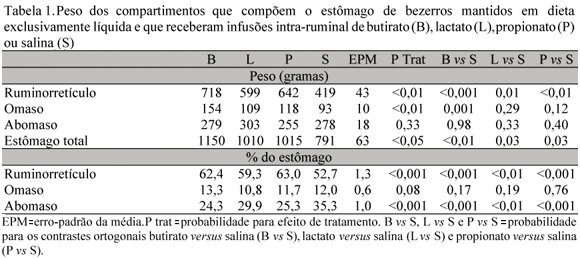The effect of butyrate, propionate, and lactate on ruminal wall, epidermis of nasolabial surface, perioplum, and epicera of 17 neonatal calves was evaluated. The experiment also aimed to validate the procedure and interpretation of tegument biopsies as indicators of ruminal mucosa alterations. Serum insulin was sampled on the 22nd day from the beginning of treatments, at 0, 90, 180, and 360 minutes after the morning infusion. After slaughtering, samples were collected from ruminal wall, nasolabial surface, epicera, and perioplum from face and hindquarters. All volatile fatty acids (VFA) induced greater increase in ruminal-reticulum proportionate weight than in omasum. Butyrate was a greater stimulator of non-glandular stomach growth. Although butyrate stimulated more insulin secretion, this VFA was not capable to induced gain on papillae area or height. The effect of nasolabial surface VFA infusion was the opposite to that observed in the rumen. VFA increased hind perioplum mitotic index, contrary to its effect on the nasolabial surface and epicera. VFA effects on ruminal mucosa morphology and on other keratinized tissues suggest that morphological damage on hoof and ruminal epithelium may have a common cause. Tegumentary biopsies may be useful as indicators of morphological alterations of ruminal mucosa.
calf; volatile fatty acids; nasolabial surface; epicera; perioplum






